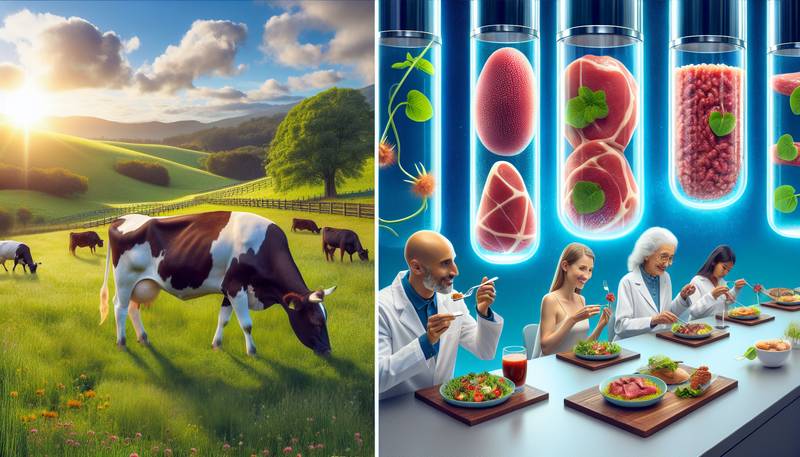Chewing the Future: Lab-Grown Meat

A Good Slice of InnovationIt might seem like the stuff of science fiction, but lab-grown meat has stepped off the pages of a novel and into our dinner plates. Imagine a world where cows can graze peacefully in fields while their cellular counterparts are cultivated in a cozy lab. Yes, the future of meat is here, and it’s less about the moo and more about the “woohoo!” Once upon a time, the biggest dilemma for meat lovers was whether to have a juicy steak or a mouthwatering burger. Now, we have the luxury of a guilt-free choice, allowing us to flex our culinary muscles without the ethical baggage. The idea is to cultivate muscle cells without the need for an actual animal, which is neat as long as we can avoid naming the lab-grown meat “Bovine Billy.” The Process: Science or Sorcery?To understand lab-grown meat, one must delve into the magical realm of biotechnology. Well, it’s not quite magic—no wands or capes necessary. Scientists take a small sample of animal cells and feed them a nutrient-rich broth that could almost be mistaken for a fancy cocktail. Over time, these cells multiply, creating the delicious morsels we dream of.★ Step 1: A tiny biopsy from an animal. No dramatic surgeries involved; it’s more like a quick check-up.★ Step 2: Cells are placed in a growth medium, which is neither green slime nor fairy dust but a scientifically crafted mixture.★ Step 3: The cells proliferate, turning into muscle tissue—yes, actual meat—without the mooing.This process takes time and meticulous care, reminiscent of trying to grow a houseplant without killing it. With lab-grown meat, however, the stakes are high; no one wants a petri dish turned into a sci-fi horror movie! If being a hero for the planet is on your bucket list, congratulations! Lab-grown meat is often touted as a greener alternative to conventional farming. It has the potential to reduce land use, decrease greenhouse gas emissions, and save water—making it a triple threat against climate change. Consider these stats:★ Up to 96% fewer greenhouse gases compared to traditional meat production.★ A fraction of the land required, allowing us to repurpose those fields for more fun stuff, like parks or amusement rides.★ Less water consumption, which means fewer cows to hydrate, resulting in a lot less bovine bellyaching.As lab-grown meat becomes more mainstream, it poses a significant opportunity for environmental sustainability. The more lab meat we produce, the less we need of the traditional stuff, allowing Mother Nature to take a breath of fresh air. “Moo-ve” over, old practices!Let’s get down to the heart of the matter: taste. After all, no one’s going to switch to lab-grown meat for the aesthetics of a petri dish. Early lab-grown products have had mixed reviews, with some tasting heavenly while others, well, let’s just say they’re still waiting for a boost of flavor.A few brave souls have already dared to taste this futuristic fare. Reports indicate a range of sensations:★ Deliciously realistic: Like biting into a traditional burger, but with fewer regrets!★ Texturally intriguing: A little different from what you’re used to, like your childhood teddy bear trying to be cool in high school.★ Flavor profiles needing work: Some taste testers might describe it as slightly lacking, similar to a karaoke singer who forgot the lyrics halfway through.As innovation continues, so too will the quest for the perfect flavor. After all, nobody wants to be that person bringing the lab-grown meat to the barbecue only to be met with suspicious glances.Lab-grown meat isn’t just a culinary breakthrough; it’s a philosophical spice to our food choices. With an exponentially growing population and a planet that’s running out of resources quicker than a kid at a candy store, this could be just the recipe we need for survival. As our taste buds evolve and technology advances, lab-grown meat will likely find its place in kitchens worldwide. Every meal might soon come with a side of sustainability and a sprinkle of ethical consideration—a feast fit for a conscious eater with a side of whimsy.Let’s not forget, we may soon find ourselves debating the best lab-grown recipes instead of the age-old question of how to get your partner to eat their vegetables. Lab-grown meat isn’t merely a trend; it’s a revolution that promises to change our dining habits forever. Who knows? Maybe your next burger will come from a lab rather than a pasture, but at least you won’t have to worry about where the cow is grazing. With a little bit of patience and a lot of creativity, the dinner table of the future may be something we can all chew on together!
|
|







